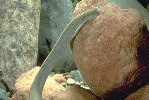http://www.fishbase.org/Summary/speciesSummary.php?genusname=Ichthyomyzon&speciesname=bdellium ---> http://192.134.151.83/Summary/speciesSummary.php?genusname=Ichthyomyzon&speciesname=bdellium
http://192.134.151.83/Summary/speciesSummary.php?genusname=Ichthyomyzon&speciesname=bdellium ---> https://fishbase.mnhn.fr/Summary/speciesSummary.php?genusname=Ichthyomyzon&speciesname=bdellium
https://fishbase.mnhn.fr/Summary/speciesSummary.php?genusname=Ichthyomyzon&speciesname=bdellium ---> https://fishbase.mnhn.fr/summary/Ichthyomyzon-bdellium.html
Ichthyomyzon bdellium, Ohio lamprey

You can
sponsor
this page
Common name (e.g. trout)
Genus + Species (e.g. Gadus morhua)
-

-
About this page
-
Languages
-
User feedbacks
-
Citation
-
Uploads
-
Related species
-


 Ohio lamprey
Upload your
photos
and
videos
Ohio lamprey
Upload your
photos
and
videos
Pictures
|
Google image
 Ichthyomyzon bdellium
Ichthyomyzon bdellium
Picture by
The Native Fish Conservancy
Petromyzonti (lampreys) >
Petromyzontiformes
(Lampreys) >
Petromyzontidae
(Northern lampreys) > Petromyzontinae
Etymology:
Ichthyomyzon:
ichthys
, fish;
myzon
(Gr.), to suck (borrowed from
Petromyzon
), i.e., a sucking fish, referring to their suctorial behavior. (
See ETYFish
)
;
bdellium:
-ium
, Latin adjectival suffix:
bdella
(Gr.) leech, referring to its leech-like suctorial and/or parasitic feeding behavior (as adults). (
See ETYFish
)
.
More on author:
Jordan
.
Environment: milieu / climate zone / depth range / distribution range
Ecology
Freshwater; demersal. Temperate; 43°N - 34°N
North America: Ohio River basin from extreme southwestern New York west to northern Indiana and eastern Illinois and south to northern Alabama in USA.
Size / Weight / Age
Maturity: L
m
?
range ? - ? cm
Max length : 30.0 cm TL male/unsexed; (Ref.
5723
); 30.5 cm TL (female); common length : 19.2 cm TL male/unsexed; (Ref.
12193
); max. reported age: 1.00 years (Ref.
12193
)
Short description
Morphology
|
Morphometrics
Distinguished by the following characters: oral disc as wide or wider than head; teeth sharp and well developed; usually 56-62 trunk myomeres; black on lateral-line pores; one slightly notched dorsal fin (Ref.
86798
). Other diagnostic features: 11.7-27.9 cm TL. Body proportions, as percentage of TL (based on 51 specimens measuring 12.5-25.9 cm TL): prebranchial length, 10.4-14.0; branchial length, 7.6-10.7; trunk length, 47.3-54.3; tail length, 21.4-31.2; eye length, 0.6-1.8; disc length, 6.2-9.5. The urogenital papilla length, as a percentage of branchial length, in 10 spawning males measuring 11.7-24.7 cm TL, 8.7-16.0. Trunk myomeres, 53-62. Dentition: supraoral lamina, 2-3 teeth (if 3, the median one shortest); infraoral lamina, 5-11 teeth; typically 4 endolateral teeth on each side, but 5 teeth also occur; 7-10, mode of 8, bicuspid endolaterals in total, the other endolaterals, if any, unicuspid; 3-4 rows of anterials, usually 3; first row of anterials, 3 teeth, all unicuspid; 4-8 rows of exolaterals on each side, usually 6; 2 rows of posterials; first row of posterials, 8-9, all unicuspid; transverse lingual lamina moderately to strongly w-shaped, with numerous cusps; longitudinal lingual laminae, number of teeth unrecorded. Velar tentacles, 2-3, smooth. Body coloration (live), slate gray dorsal aspect and silvery gray lateral and ventral aspects. Lateral line neuromasts darkly pigmented, although they may be unpigmented in recently transformed adults. Caudal fin pigmentation, 75% or more. Caudal fin shape, rounded. Oral fimbriae, 103-144. Oral papillae, 20-32 (Ref.
89241
).
Inhabit smaller, more upland rivers, and less encountered in reservoirs (Ref.
10294
). Freshwater. Ammocoetes and spawning adults inhabit brooks and small rivers, while feeding adults inhabit medium-sized to large rivers (Ref.89241). Ammocoete larvae live near debris in muddy pools and backwaters. Known to parasitize suckers (Ref.
10294
).
Life cycle and mating behavior
Maturity
|
Reproduction
|
Spawning
|
Eggs
|
Fecundity
|
Larvae
Page, L.M. and B.M. Burr
, 1991. A field guide to freshwater fishes of North America north of Mexico. Houghton Mifflin Company, Boston. 432 p. (Ref.
5723
)
IUCN Red List Status (Ref.
130435
)
Least Concern (LC)
; Date assessed:
17 February 2012
CITES
Not Evaluated
Not Evaluated
Threat to humans
Harmless
Human uses
FAO - Publication:
search
|
FishSource
|
More information
Countries
FAO areas
Ecosystems
Occurrences
Introductions
Stocks
Ecology
Diet
Food items
Food consumption
Ration
Common names
Synonyms
Metabolism
Predators
Ecotoxicology
Reproduction
Maturity
Spawning
Spawning aggregation
Fecundity
Eggs
Egg development
Age/Size
Growth
Length-weight
Length-length
Length-frequencies
Morphometrics
Morphology
Larvae
Larval dynamics
Recruitment
Abundance
BRUVS
References
Aquaculture
Aquaculture profile
Strains
Genetics
Electrophoreses
Heritability
Diseases
Processing
Nutrients
Mass conversion
Collaborators
Pictures
Stamps, Coins Misc.
Sounds
Ciguatera
Speed
Swim. type
Gill area
Otoliths
Brains
Vision
Tools
E-book
|
Field guide
|
Identification keys
|
Length-frequency wizard
|
Life-history tool
|
Point map
|
Classification Tree
|
Catch-MSY
|
Special reports
Check for Aquarium maintenance
|
Check for Species Fact Sheets
|
Check for Aquaculture Fact Sheets
Download XML
Summary page
|
Point data
|
Common names
|
Photos
Internet sources
AFORO (otoliths) |
Aquatic Commons
|
BHL
|
Cloffa
|
BOLDSystems
|
Websites from users
|
Check FishWatcher
|
CISTI
|
Catalog of Fishes
:
genus
,
species
|
DiscoverLife
|
ECOTOX
| FAO - Publication:
search
|
Faunafri
|
Fishipedia
|
Fishtrace
| GenBank:
genome
,
nucleotide
| GloBI |
Google Books
|
Google Scholar
|
Google
| IGFA World Record |
MitoFish
|
Otolith Atlas of Taiwan Fishes
|
PubMed
| Reef Life Survey | Socotra Atlas |
Tree of Life
| Wikipedia:
Go
,
Search
| World Records Freshwater Fishing |
Zoological Record
Estimates based on models
Phylogenetic diversity index (Ref.
82804
): PD
50
= 0.5156 [Uniqueness, from 0.5 = low to 2.0 = high].
Bayesian length-weight: a=0.00107 (0.00040 - 0.00285), b=3.03 (2.81 - 3.25), in cm total length, based on LWR estimates for this (Sub)family-body shape (Ref.
93245
).
Trophic level (Ref.
69278
): 4.4 ±0.8 se; based on size and trophs of closest relatives
Resilience (Ref.
120179
): Low, minimum population doubling time 4.5 - 14 years (Semelparous species, assuming tm (= tmax) > 4).
Fishing Vulnerability (Ref.
59153
): Low vulnerability (21 of 100).
Back to Search
Random Species
Back to Top
Accessed through:
Not available
FishBase mirror site :
localhost
Page last modified by :
mrius-barile
- 20 July 2016
Fatal error
: Uncaught ArgumentCountError: Too few arguments to function checkEcotox(), 1 passed in /var/www/html/summary/speciessummary.php on line 2304 and exactly 3 expected in /var/www/html/includes/speciessummary.lib.php:2579 Stack trace: #0 /var/www/html/summary/speciessummary.php(2304): checkEcotox() #1 {main} thrown in
/var/www/html/includes/speciessummary.lib.php
on line
2579
|